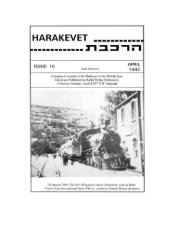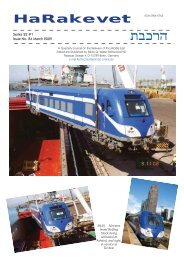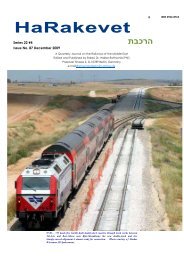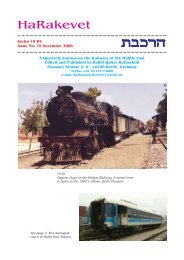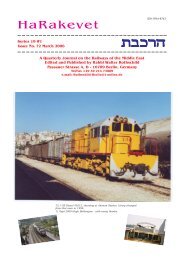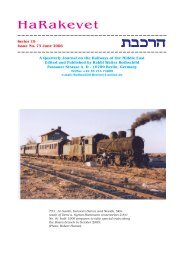Create successful ePaper yourself
Turn your PDF publications into a flip-book with our unique Google optimized e-Paper software.
format files if required, free of charge. If anyone<br />
wants a printed version - well, there are a lot of<br />
pages to photocopy and post, and I cannot give an<br />
exact price yet, but it could be done.<br />
(iv) . BIRKENAU.<br />
Relevant in the broader context of<br />
,Harakevet' - a former Deutsche Reichs-bahn<br />
goods van has been placed as a memorial on the<br />
tracks at Auschwitz-Birkenau. An article in<br />
,Ha'aretz' 24.01.2010 p.A4 describes the search for<br />
a suitable vehicle<br />
- which is due to be officially dedicated at Yom<br />
HaShoah in April; it represents also a change in<br />
policy, through new members of the management<br />
team, inasmuch as until now it had been the ruule<br />
that nothing was to be brought to the museum that<br />
was not ,authentic' due to having been on site when<br />
the camp was liberated.<br />
The search for a suitable original<br />
vehicle lasted two years, and was eventually<br />
brought to a successful conclusion by Micha<br />
Limor, a journalist, who was able to track down a<br />
van standing in a field near Wessum, near the<br />
German-Dutch border<br />
The״ owner of the car, a local doctor and train -<br />
aficionado, said he had bought it from british<br />
soldiers in 1990, shortly before they left Germany.<br />
The British used it for storing tools, but he hoped to<br />
restore it and make it a museum exhibit when he<br />
had the time and money." It had been built in 1921<br />
and research indicated it had indeed been used in<br />
deportation trains from Hungary during the War. A<br />
firm ,Die Schmiede' was tasked with some initial<br />
restoration, following which the wagon was<br />
brought by road<br />
to Auschwitz on 15-17. Sept. 2009.<br />
(v) . MODEL OF ROD LOCOS.<br />
Tony Travis advises that Bach-mann is<br />
planning to produce a 4mm OO version of the<br />
Great Central Railway 8K<br />
(LNER 04) 2-8-0 locomotive, as used by<br />
the Railway Operating Division in the First World<br />
War and hence referred to as ,ROD's' when they<br />
were used in the Middle East by the military in the<br />
Second World War.<br />
(vi) : BACKGROUND TO THE IC3's.<br />
In ,Today's Railways' No. 115<br />
(July 2005) p. 35 is:-<br />
units)... The)״ story of the Spanish TRD<br />
dates back to late 1985 when Danish Railways<br />
(DSB) ordered 23 3-car articulated DMUs with<br />
four powered bogies from Ascan Scandia. Known<br />
as IC3, these units have a top speed of 160 km/h,<br />
lively acceleration (1m/s2) and powerful braking<br />
(160 km to rest in one kilometre), with<br />
microprocessor train control. Their most striking<br />
characteristic is their cab ends, which are<br />
surrounded by a massive rubber ring. When the<br />
sets are running in multiple (up to five sets), all<br />
intermediate cab ends, including windscreen and<br />
console, are swung through 90deg. and neatly<br />
folded away into cabinets, thus providing wide<br />
inter-car gangways the length of the train. Rapid<br />
coupling and uncoupling is possible. In Denmark<br />
this is necessary -a five-unit set departing from<br />
Page 18<br />
Kobenhavn comprises portions for four different<br />
destinations - Sonderborg, Esbjerg, Struer and<br />
Frederikshavn.<br />
Delivery of the DSB IC3s ran late,<br />
with on-board software teething troubles<br />
compounded by the bankruptcy of ABB<br />
Scandia, its subsequent restructuring as<br />
Scandia-Randers A/S, and finally by the<br />
incorporation of the rail industry sector of<br />
ABB in Adtranz. The first commercial services<br />
started in January 1990 ......... "<br />
(vii) . PRESERVATION PROPOSAL.<br />
Worthy of recording, though<br />
there is as yet nothing much to report, is<br />
an attempt by Alon Siton to arouse sufficient<br />
interest within Israel to retain for preservation<br />
enough former Esslingen railcar<br />
units to provide a full set, for possible use<br />
even on tourist trains along the old Jerusalem<br />
line. He has listed the remains, some<br />
of them only partially complete or even rebuilt<br />
as hauled stock. Although the<br />
Editor supports such ideas enthusiastically,<br />
we are not in a position to help in a concrete<br />
manner, and the Railway Museum in<br />
Haifa under Chen Melling as Deputy Director<br />
also suffers from lack of resources<br />
and help from ,at the top'. This is an issue<br />
which occurs also in other countries - a<br />
multiple-unit or a train set is, by definition,<br />
a ,set' and not just an individual vehicle; yet<br />
whilst it is sometimes possible to preserve<br />
and restore a single coach (or wagon - see<br />
above), the idea of a complete set of two,<br />
or three, or five or more vehicles - an entire<br />
,TEE set, for example - is much more difficult.<br />
And one needs a cab unit at each<br />
end. But once an item has gone, it has<br />
gone .. for ever. So one hopes the idea is<br />
not wholly dead .... and we will continue to<br />
report on any developments.<br />
(viii) . SYBIL'S ADVENTURE.<br />
On Sunday 17.01.2010 Sybil Ehrlich wrote:-<br />
excit- Just״ got back from an<br />
ing day (Sunday January 17). My plan<br />
was to get a train to Ganei Aviv and explore<br />
the area around Sarafand Junction<br />
and if possible to walk along the<br />
old Sarafand trackbed.I got the 11:23<br />
from Beit Shemesh. As we neared Lod<br />
there was an announcement that the<br />
train would terminate at Lod because<br />
of a takala״ bema'arechet" (system<br />
breakdown). That was OK as far as I<br />
was concerned because I was changing<br />
at Lod anyway. Arrived at<br />
Lod on time, 11:56, and I expected<br />
to wait till 12:30 for the train to Ganei<br />
Aviv. I went up on the footbridge and<br />
to my amazement I saw trains coming<br />
and going on the inland line! A northbound<br />
train came in on platform 2 and<br />
was announced as Haifa and Nahariya<br />
הרכבת<br />
only, passengers for Tel Aviv should go<br />
to platform 4. The train from Beit<br />
Sh-emesh went back at 12:11.<br />
So I went to the stationmaster's office to<br />
find out what was going on. Someone had flung<br />
himself on the line at Azor, causing all this<br />
disruption, so some trains were not going via Tel<br />
Aviv. 12:30 had come and gone, and so had a train<br />
for TA calling at Kfar Chabad. I asked the<br />
stationmaster when the next train to Ganei Aviv<br />
would be, and he said 13:30. That's OK, I can<br />
happily spend a few hours up there on the<br />
footbridge.<br />
At 13:20 I went to the loo on platform<br />
1/2, and when I came out there was a<br />
Siemens train in platform 2!!! And there was<br />
an announcement that the train on platform 2<br />
was for B'nei Brak, Binyamina, Atlit and<br />
Haifa. By the time my brain registered this<br />
properly, it was too late to buy a ticket for<br />
B'nei Brak and hop aboard. I missed a<br />
once-in-a-lifetime opportunity to go via<br />
Rinatya (Rantiyeh) to B'nei Brak on a<br />
Siemens. I'm still kicking myself. By this<br />
time it was total chaos in the stationmaster's<br />
office with angry passengers demanding to<br />
know what was going on and could they get a<br />
refund, and telephones ringing in all<br />
directions. I got a word in to ask when there<br />
would be a train to Ganei Aviv and he said he<br />
didn't know. I asked whether there would be<br />
another train via Rina-tya to B'nei Brak<br />
within the next hour and he said no. So I<br />
decided I'd had enough, and walked to<br />
Sarafand Junction (site of). I found a couple<br />
of bridges on the Sarafand branch, very close<br />
to the junction, and it was easy walking along<br />
the embankment all the way out to Road 44,<br />
from where there are buses to Beit Shemesh.<br />
On the way I saw a man on a horse. We<br />
exchanged a few words, and I said I was<br />
walking along the old trackbed and did he by<br />
any chance know when the track had been<br />
lifted. He said years ago, ״12 years". I<br />
realised that 12 was just a number plucked<br />
out of thin air, and he could have said three<br />
years or 43 years. Anyone know? Incredibly,<br />
the line is still shown on maps published in<br />
2008.<br />
Coming back on the bus, we stopped<br />
at 16:40 at the old level crossing in<br />
Ram-le (the one to the south of the old<br />
concrete station) and a Siemens bound for<br />
Beer-Sheba went across! Whether this is now<br />
standard or was because of the morning's<br />
disruption I have no idea."



